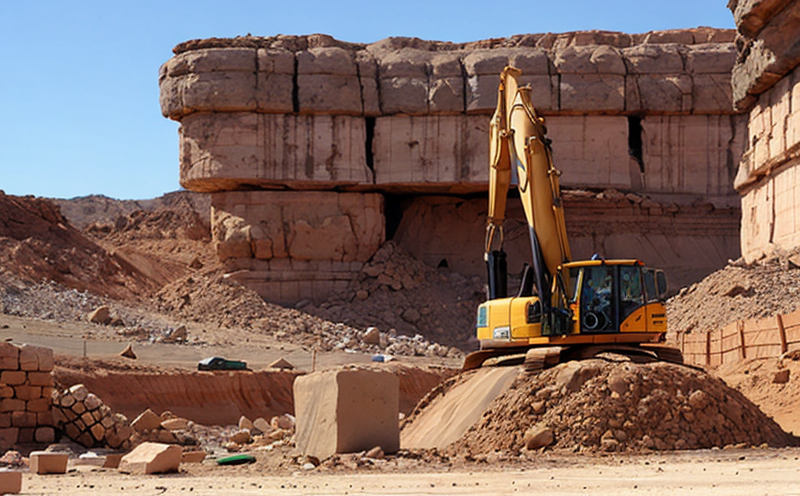JGS 0542 Point Load Strength Index of Rock Testing
The JGS 0542 Point Load Strength (PLS) test is a critical measurement in the field of geotechnical and mining testing. It provides essential data on rock strength which is crucial for assessing stability, durability, and safety within various mining operations.
Point Load Strength testing is particularly important in sectors where rock integrity plays a significant role in operational success and worker safety. This includes underground mining environments, tunnel construction projects, and other civil engineering applications involving rock formations. The test helps engineers and geologists make informed decisions about the suitability of rocks for various uses.
The PLS index measures how much load a given specimen can withstand before it fails under axial compression at a point. This is achieved by applying a gradually increasing load to a cylindrical or disc-shaped rock sample until failure occurs, after which the maximum load applied just before failure is measured. The strength is then calculated using the formula: PLS = (2 x Fmax)/πd², where Fmax is the maximum force and d is the diameter of the specimen.
This test adheres to international standards such as ISO 17863-4, ASTM D5079, and EN 12370. It ensures consistency across different laboratories worldwide, providing reliable data that can be used for quality assurance and regulatory compliance.
Preparation of the specimen is critical in obtaining accurate results. The rock must be carefully selected to ensure it represents the characteristics of the material under investigation. Specimens are typically cut from larger pieces using diamond wire saws or other precise cutting tools, ensuring they meet specific dimensions as per the standard. Once prepared, specimens undergo cleaning and drying processes before being tested.
The testing equipment used in this process is highly specialized. It includes a point load tester capable of applying controlled loads while accurately measuring forces. These testers are often computer-controlled to ensure precision and repeatability. The setup involves placing the specimen between two conical points, one stationary and one movable, which then applies pressure until failure.
Once testing is complete, results must be analyzed thoroughly. Engineers use these data points to assess factors like rock quality factor (RQD), uniaxial compressive strength, and modulus of elasticity among others. This information assists in predicting potential weaknesses within a mine structure or tunnel wall, helping prevent accidents and costly repairs.
In practical application, mining companies rely heavily on PLS tests during site evaluation stages to determine appropriate excavation methods and support systems needed for safe extraction operations. Understanding rock behavior through such testing ensures better planning and execution of projects, ultimately enhancing overall safety standards within these industries.
Scope and Methodology
| Step | Action | Description |
|---|---|---|
| 1 | Select Specimen | Pieces of rock are carefully chosen to represent the material being tested. |
| 2 | Cut Specimen | Using diamond wire saws, specimens are cut into cylindrical or disc shapes. |
| 3 | Clean Specimen | The specimen is cleaned thoroughly to remove any dirt or debris. |
| 4 | Dry Specimen | The cleaned specimen is dried according to specified procedures. |
| 5 | Mount Specimen | The specimen is mounted between two conical points on the testing machine. |
| 6 | Apply Load | The testing machine gradually applies load until failure occurs. |
| 7 | Analyze Results | Data from each test run is analyzed to determine the Point Load Strength Index (PLSI). |
The methodology outlined above ensures that every aspect of the PLS testing process adheres strictly to established protocols, thereby ensuring accurate and reliable results.
Eurolab Advantages
- ISO 17863-4 Compliance: Ensures all tests meet international standards for precision and accuracy.
- Advanced Testing Equipment: Utilizes state-of-the-art machinery to provide consistent results across multiple samples.
- Expert Technicians: Our team comprises highly trained professionals who ensure every step of the process is executed flawlessly.
- Comprehensive Reporting: We offer detailed reports that not only include PLS values but also other relevant parameters like RQD and uniaxial compressive strength.
- Prompt Turnaround Time: Deliver results quickly so you can make informed decisions promptly.
- Diverse Sample Handling: Capable of testing a wide range of rock types, ensuring accurate assessments for various mining sites worldwide.
At Eurolab, we pride ourselves on offering comprehensive services that go beyond just providing test results. Our commitment to excellence ensures clients receive reliable data they can trust when making important decisions related to their projects.





